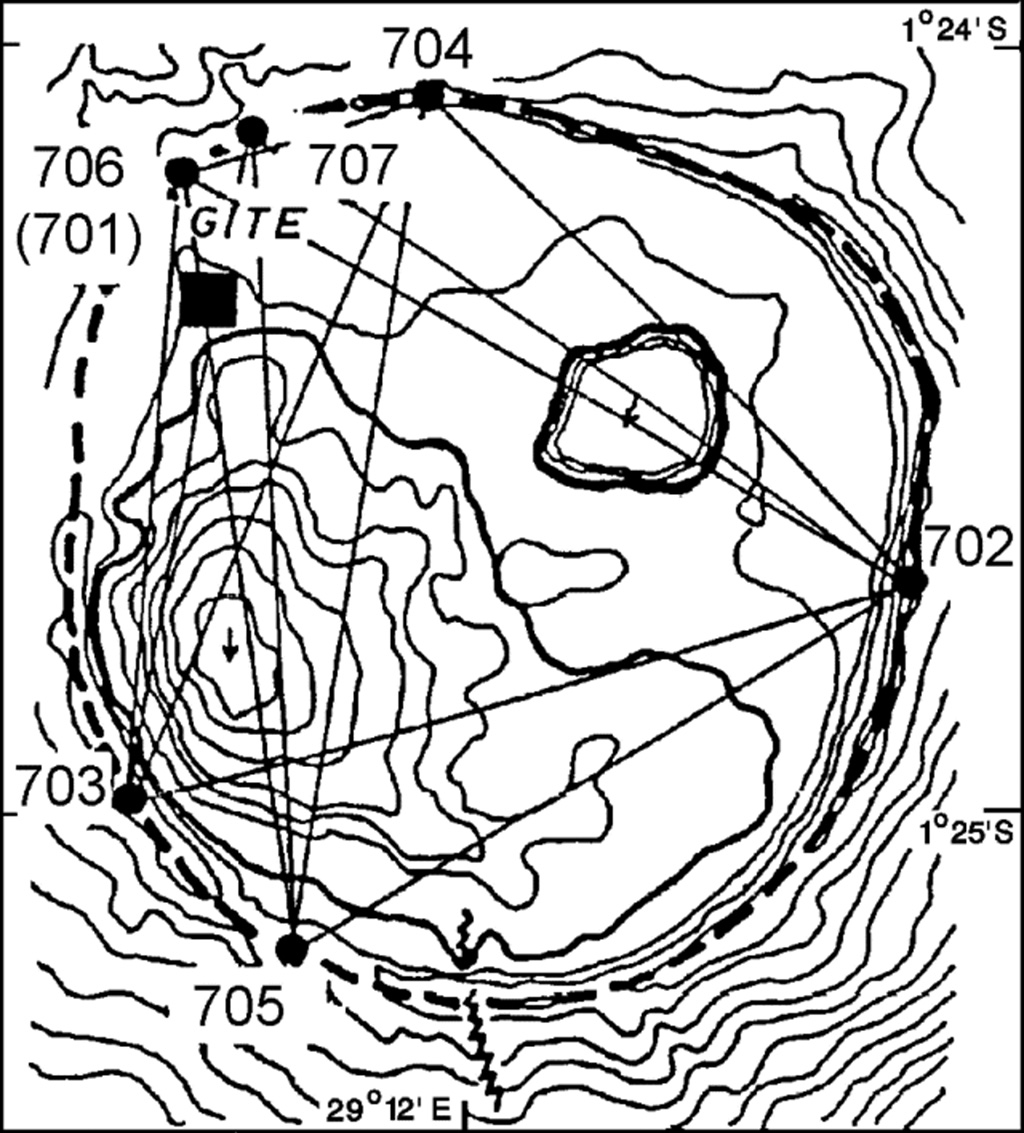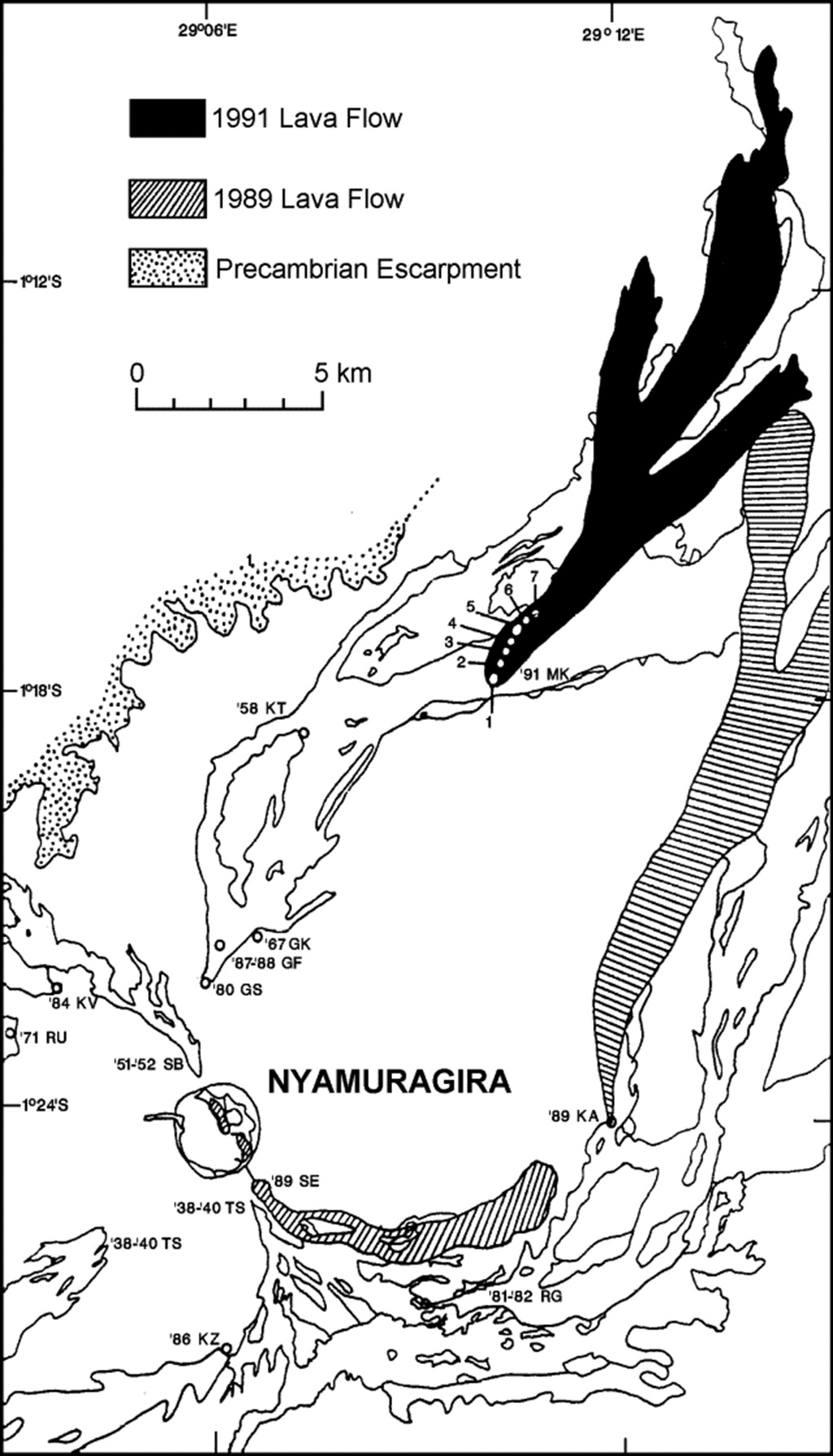Report on Nyamulagira (DR Congo) — May 1989
Scientific Event Alert Network Bulletin, vol. 14, no. 5 (May 1989)
Managing Editor: Lindsay McClelland.
Nyamulagira (DR Congo) Inflation precedes fissure eruption; large lava flows
Please cite this report as:
Global Volcanism Program, 1989. Report on Nyamulagira (DR Congo) (McClelland, L., ed.). Scientific Event Alert Network Bulletin, 14:5. Smithsonian Institution. https://doi.org/10.5479/si.GVP.SEAN198905-223020
Nyamulagira
DR Congo
1.408°S, 29.2°E; summit elev. 3058 m
All times are local (unless otherwise noted)
In August and September 1988, M. Kasahara of Hokkaido Univ and K. Mukeng of the CRSN in Lwiro performed a geodetic survey of the summit crater along eight baselines (figure 7). The measurements showed inflation of the crater in all directions with the principal strain oriented N49°E. [The deformation caused geologists to expect either a rejuvenation of the lava lake or future eruptive activity in the central crater.]
 |
Figure 7. August-September 1988 geodetic survey of Nyamuragira's summit crater. Courtesy of M. Kasahara and K. Mukeng. |
On 24 April [1989] at 1325, a small NW-trending fissure opened in the central part of the summit crater, emitting lava that flowed S (figure 8) and a mushroom-shaped ash plume that was observed at Katale seismic station (~20 km from the crater). Thirty minutes later, a second vent opened on the SE slope ~500 m from the crater rim. Activity continued until 26 April, producing a flow 8 km long and 400 m wide.
A third vent (named Kimanura) opened 26 April ~500 m N of the 1905 (Kanamaharagi) cone (1.43°S, 29.3°E, altitude 1,869 m). The vent propagated S and lava production was confined to a zone just W of the 1905 cone. When geologists visited the vent on 14 May, they observed continuous lava fountaining and frequent bomb ejection. A new cone 300-400 m in diameter stood 80 m high and an active lava flow (intermittently forming tubes) extended 20 km N. After 24 May, fountaining became intermittent and activity changed to Strombolian type. Vigorous scoria emission accompanied the initial activity of both the SE flank and Kimanura vents. Scoria deposits extended >5 km W of Kanamaharagi cone.
Geological Summary. Africa's most active volcano, Nyamulagira (also known as Nyamuragira), is a massive high-potassium basaltic shield about 25 km N of Lake Kivu and 13 km NNW of the steep-sided Nyiragongo volcano. The summit is truncated by a small 2 x 2.3 km caldera that has walls up to about 100 m high. Documented eruptions have occurred within the summit caldera, as well as from the numerous flank fissures and cinder cones. A lava lake in the summit crater, active since at least 1921, drained in 1938, at the time of a major flank eruption. Recent lava flows extend down the flanks more than 30 km from the summit as far as Lake Kivu; extensive lava flows from this volcano have covered 1,500 km2 of the western branch of the East African Rift.
Information Contacts: N. Zana, CRSN, Bukavu; H-L. Hody, GEOVAR, Kigali, Rwanda.


